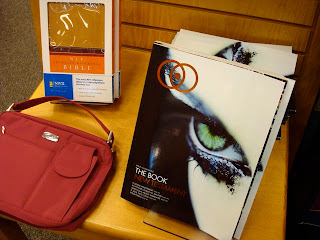From the FAQ on J. Mark Bertrand's Bible Design and Binding blog:
Q. Isn't it frivolous to talk about the design of Bibles instead of the content?
You'll get no argument from me. It's much better to read a Bible that falls apart after a year of use than to own a finely-made edition that sits on the shelf, nothing more than an objet d'art. To be honest, though, when people make snide remarks about the superficial focus of the blog, as they occasionally do, I'm inclined to point out that a discussion like this isn't any more frivolous than just about every discussion taking place online. With so many English translations of the Bible in print, and so much substantial agreement between them, is it frivolous to discuss the instances where they differ? Not if translation is your passion. The same is true for design. It's not the most urgent issue in the world, but that's just fine. I wouldn't enjoy conversation very much if we were only permitted to shout.
And consider this: while design might seem invisible, it has a major impact on the way readers experience the text. I discovered this firsthand by reformatting the text of the KJV for college-age students. When the words looked right, they were much easier to understand than before. Good design can enhance a good translation, and improve a poor one.
Though we might not often think about it this way, a book is a technology for reading. When we spend time with our eyes focused on little ink squiggles ranged across a sea of white paper, the ink and the paper transform; a whole is created that is more than the sum of these elements. In this transformation, information is communicated.
In order to be read, the physical corpus of a book must, of course, be visible. However, in the process of reading, the book also becomes strangely invisible. What we seem to see, what we focus on, are the meanings and information that arise from the transformation of the ink squiggles and paper, not the squiggles and paper itself. And yet, we would not have any information conveyed at all if we did not focus entirely on the ink squiggles and paper itself.
In other words, if we want to talk precisely about the "there" of reading, we might find that this "there" is somewhat hard to pin down. Our mind's eye gets invovled, and these strange creatures we call "author's voice" and "intention" demand negotiation, the past and elsewhere bargaining with the here and the now. It can get confusing.
If you haven't spent time yet exploring Mark Bertrand's excellent blog posts about Bible construction, let me suggest this as a good starting point. I haven't been in contact with Mark yet, and I am not sure he shares my deep (and theory-laden) cynicism about mass-market Bible production. However, I have nothing but praise for what I have seen so far in my explorations of his site. I especially like his commitment to thinking of the end-user of a Bible (whatever the style or denominational commitment) as a reader, and not (as is too-often the case) as a consumer.
Which brings us back to the point made in his FAQ above. When a reader is at work, she does not consume - she creates. A reader is an active participant in the establishment of meanings from interaction with ink squiggles and paper. The book is not consumed in this process - though we can definitely point to books published with cheap materials and bindings that are damaged by this process. But, as Mark points out, this needn't always be the case.
What I am most fascinated by, however, is this matter of invisible design, hinted at above. The book is a technology, part of media technology. This means that the Bible, as a book, is a medium. As a medium, it can be seen both as a conveyance and as a conjurer of spirits - Holy and otherwise.
When we look at the Bible, when we look at this book, we see the book itself - but we also see invisible things. Meanings, intentions, designs, fonts, heft, interactivity, quality, smells, paper thickness - each of these tangibly and intangibly shapes our experience of the Bible as a book, and this is true for whatever Bible we happen to be holding.
In looking at the materiality of Scripture, we are chasing ghosts by focusing on the concrete object in front of us.





